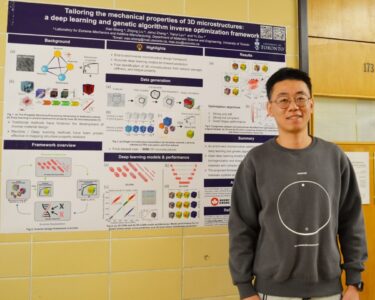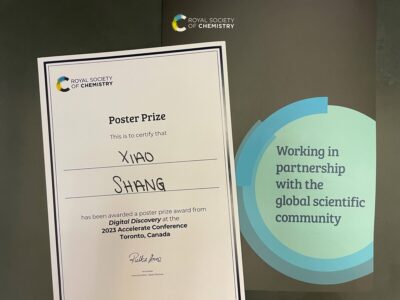
Xiao Shang, an MSE PhD student in Professor Yu Zou’s research group , received the poster prize at the Accelerate Conference. He was honored with the award by the Acceleration Consortium and the Royal Chemistry Society. The Acceleration consortium, based at the University of Toronto, is in the process of establishing six to seven self-driving laboratories. The conference they have organized focuses on material discovery, specifically utilizing machine learning models in conjunction with self-driving laboratories. We extend our congratulations to Xiao, and the department eagerly anticipates his future endeavors. Deena Adamjee had the opportunity to interview Xiao about his award.
Tell me about your project?
I created a framework for customizing the mechanical properties of 3D microstructures using deep learning and a genetic algorithm. This framework employs microstructures and data from FEA calculations. Two deep learning models are trained: one to forecast the global stress-strain relationship, and the other to predict the localized stress distribution map. Subsequently, these two deep learning models are integrated into an inverse design loop alongside a materials genetic algorithm. The framework requires input target mechanical properties, including Young’s modulus, strength, and the stress-concentration factor, which indicates fatigue properties. To evaluate a microstructure’s quality in the genetic algorithm, the two deep learning models are utilized. This framework significantly accelerates the process to create application-specific microstructures, which could take years or decades using traditional trial-and-error or simulation-based methods.
The framework’s effectiveness is demonstrated in two application cases. The first case pertains to aerospace applications, where the goal is to maximize strength and stiffness to ensure strong and rigid structures. The second case focuses on biomedical applications, where the microstructure needs to be both strong and compliant to match the bone’s modulus. These two applications involve a trade-off, and the framework enables the exploration of microstructures that are suitable for each specific application.
Xiao’s work can be accessed using this link
What about your poster do you think stood out?
This framework, which I refer to as “end-to-end,” simplifies the process. You only need to specify the desired mechanical property, and the framework will identify the optimal microstructure for you. Within this framework, we’ve trained precise Deep Learning Models for what we term “forward prediction.” These models can rapidly determine the ideal microstructures based on your specified criteria, such as strength, stiffness, and fatigue properties.
What does winning this award mean for you and your research?
It serves as a motivating factor for me to continue my work. Having just completed this project and being in my third year of my PhD, this recognition is encouraging. It signifies that my efforts could have an impact on the field of material discovery. Additionally, it reflects the growing influence of deep learning and machine learning in our community, benefiting society as a whole.
What projects are you looking to undergo after this one?
In this project, my work has primarily focused on computational aspects, resulting in the generation of 3D microstructure models. Looking ahead, I plan to shift more towards the experimental side of things. I’ll be working with 3D printers, one of which I’ve personally been in charge of assembling in Prof. Zou’s lab. Initially, I’ll be working on optimizing processing parameters to ensure the printer functions effectively. Ultimately, my goal is to leverage additive manufacturing to produce the microstructures identified by this framework. The vision is to seamlessly combine these two components: specifying a desired mechanical property, running the framework to obtain the microstructure, and then using a 3D printer to bring it to life for practical applications.
What field are you looking to get into after your PhD?
I’m genuinely enthusiastic about pursuing a career in academia, particularly in securing a faculty position where I can continue my research. This recognition and prize hold significant personal value for me, as it further fuels my passion and dedication to my work. It has me eagerly anticipating the future research endeavours I will be embarking on.
